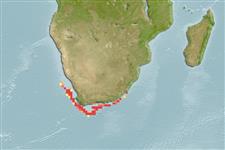Elasmobranchi (squali e razze) (sharks and rays) >
Rajiformes (Skates and rays) >
Rajidae (Skates)
Etymology: Neoraja: Greek, neos = new + Latin, raja = fish, Raja sp. (Ref. 45335).
Eponymy: Dr Matthias F W Stehmann (d: 1943) is a German ichthyologist whose university career at Kiel University (1962–1969) resulted in degrees covering marine sciences, zoology and limnology and culminated with a doctorate in marine sciences. [...] (Ref. 128868), visit book page.
Environment: milieu / climate zone / distribuzione batimetrica / distribution range
Ecologia
marino batidemersale; distribuzione batimetrica 102 - 1025 m (Ref. 5578). Deep-water; 29°S - 40°S
Southeast Atlantic: off the Orange River mouth to south of the Agulhas Bank, South Africa.
Size / Peso / Age
Maturità: Lm ? range ? - ? cm
Max length : 37.6 cm TL maschio/sesso non determinato; (Ref. 106604)
Short description
Chiavi di identificazione | Morfologia | Morfometria
A dwarf softnose skate with a bluntly pointed snout and very large close-set eyes; tail longer than body in adult; pectoral disc angular with rounded corners, and anterior edges more undulated in adult male than in female; large thorns around eyes, on shoulders, and in interrupted single row from back to dorsal fins (Ref. 5578). Brownish-grey above, with 6-7 crossbars on tail; underside pale with dark brown areas along the front and rear edges of disc, on snout and on underside of tail (Ref. 5578).
Body shape (shape guide): other.
Found on the upper slope (Ref. 5578). Oviparous (Ref. 50449). Eggs have horn-like projections on the shell (Ref. 205). Probably taken by hake trawlers (Ref. 5578).
Life cycle and mating behavior
Maturità | Riproduzione | Deposizione | Uova | Fecundity | Larve
Oviparous, paired eggs are laid. Embryos feed solely on yolk (Ref. 50449).
McEachran, J.D. and K.A. Dunn, 1998. Phylogenetic analysis of skates, a morphologically conservative clade of elasmobranchs (Chondrichthyes: Rajidae). Copeia 1998(2):271-290. (Ref. 27314)
IUCN Red List Status (Ref. 130435: Version 2025-1)
Threat to humans
Harmless
Human uses
Strumenti
Special reports
Download XML
Fonti Internet
Estimates based on models
Preferred temperature (Fonte Biblio.
123201): 6.1 - 12.1, mean 10.8 °C (based on 9 cells).
Phylogenetic diversity index (Fonte Biblio.
82804): PD
50 = 0.5312 [Uniqueness, from 0.5 = low to 2.0 = high].
Bayesian length-weight: a=0.00646 (0.00364 - 0.01145), b=3.29 (3.14 - 3.44), in cm total length, based on LWR estimates for this species & (Sub)family-body (Ref.
93245).
Trophic level (Fonte Biblio.
69278): 3.7 ±0.6 se; based on size and trophs of closest relatives
Resilienza (Fonte Biblio.
120179): Basso, tempo minimo di raddoppiamento della popolazione 4.5 - 14 anni (Fec assumed to be <100).
Fishing Vulnerability (Ref.
59153): Low to moderate vulnerability (28 of 100).
🛈
